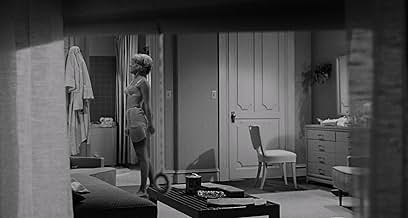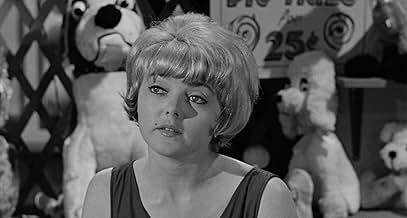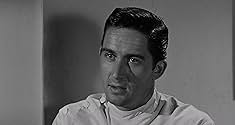VALUTAZIONE IMDb
6,6/10
1300
LA TUA VALUTAZIONE
Aggiungi una trama nella tua linguaAn overweight lab technician with low self esteem, brought on by his dominant mother, becomes a serial killer of female nurses.An overweight lab technician with low self esteem, brought on by his dominant mother, becomes a serial killer of female nurses.An overweight lab technician with low self esteem, brought on by his dominant mother, becomes a serial killer of female nurses.
- Regia
- Sceneggiatura
- Star
Michael Ryan
- Detective Mel Posner
- (as Michael M. Ryan)
Fred Aldrich
- Apartment House Manager
- (non citato nei titoli originali)
Benjie Bancroft
- Police Officer
- (non citato nei titoli originali)
Recensioni in evidenza
While this is not by any stretch of the imagination a good film, because of the slow pacing, the inane police sequences, and the thuddinmg obviousness of much of it. It still has it's imaginative stretc hes. For example, showing that the killer has an orgasm every time he kills is unusual and quitye ahead of the time. Several of the strangling scenes where suspensilly paced, but weakened by how quickly the victim usually died (it only takes him about 10 seconds to strangle each woman with a silk stocking!) and also weakened by having every woman changer into her underwear before she gets killed. Basically much of this is saved by Victor Buono's performance which is not his best, is still quite menacing and one of the more realistic serial killers on film. His exaggerated false smiles of respectability brought to mind similiar ones I had seen on the faces of John Wayne Gacy. And the scene where he trashes the apart ment the hole time his mouth workingh inadvertenly was magnificent.
This film was a pleasant surprise. I bought this on DVD with another film on same DVD because I liked the description, at a very fine price. I was not disappointed. Victor Buono of Batmans King Tut fame and Ellen Corby of Waltons fame were excellent as son and overbearing crippled mother. The scenes where Ellen Corby verbally abuses her son were as important to the film as the actual murders taking place. It truly does give the viewer somewhat of a sense as to why the killer turned out the way he did. I thought the police investigation and interrogation scenes were wonderful as well and truly stood the test of time to modern day film experiments such as Law and Order or CSI . The writers of this movie really did their homework to bring out an exceptional film in all facets, covering all bases. The film is timeless for the most part, except for smoking in the hospital. I thought that was strange lol. I surely recommend this film with an eerie soundtrack though very simple stage set. Victor Buono very underrated actor, probably because of his girth. Enjoy this film ASAP.
This film opens with a written message, announcing that the creators wish to express their gratitude to several police departments and psychiatrists for giving them access to their files and offering assistance with their research. If it weren't for them, the profile of the titular serial killer would never have been this disturbingly realistic and convincing. Now, attention-grabbing gimmicks at the beginning of a horror movie like this can either mean two things. Either it's sincere and the producers had something genuinely ambitious in mind, or it's just a cheap and sleazy trick to mislead unwarily viewers. You know, like falsely claiming a movie is based on true events. Initially I assumed it would be option number two in the case of "The Strangler". Lead star Victor Buono previously already played an obese guy with a strangely eerie mother-fixation, so it would be the ideal occasion to further exploit the success of that classic by revolving an entirely separate film on this concept. Moreover, "The Strangler" came out almost immediately after the apprehension of Alberto DeSalvo – the real life Boston Strangler – and it is prototypical for a low-budgeted exploitation movie to quickly cash in on media hypes. Four years later, director Richard Fleischer presented his version of the factual murder case, starring Henry Fonda and Tony Curtis as the infamous Alberto DeSalvo, and that particular film, and the success of that much more commonly known and widely acclaimed film is presumably the reason why "The Strangler" is a relatively obscure and hidden gem. But let me assure you there honestly isn't the slightest reason to feel skeptical or wary towards this movie. "The Strangler" is a chilling and atmospheric effort, with obvious echoes to Hitchcock's "Psycho" naturally, but also more than enough qualitative aspects of its own. It's rather brutal in tone and execution, with some extremely grim and unsettling moments (especially considering the time of release) and the vivid performance of Victor Buono is undeniably the movie's main trump. Buono depicts the naturally perverted and heavily overweight hospital lab researcher Leo Kroll. Despite of his arrogant wittiness and obvious intellect, Kroll's bed-ridden mother still dominates his life and she uses every opportunity to reassure her son that he's fat and ugly and that no woman will ever love him. Maybe that's the reason why Leo Kroll is a misogynist serial killer who already strangled eight women; all of them nurses. His trademarks are to use stockings and leave broken play dolls at the scene of the crime. The stalk-and-strangle sequences are extremely suspenseful and many of the undertones and sexual insinuations are quite controversial and ahead of their time. Buono's performance is courageous, powerful, stellar and pretty freaking convincing! Buono is authentically sinister, especially when he behaves calm and sophisticated. Great suspense flick, highly recommended!
Oddball, but enjoyable low-budget horror film features Victor Bruno as an overweight, insecure lab technician with an overbearing mother, which somehow drives him to become a serial killer, strangling nurses at the hospital where he works. "The Strangler" capitalized on Bruno's Oscar nominated performance in "Whatever Happened to Baby Jane?" and although this clearly a lesser film, it does have a low rent William Castle type of charm. Bruno carries the film, giving a creepy performance as an unassuming killer along the lines of David Berkowitz or John Wayne Gacy, far removed from the usual more flamboyant of serial killers presented on films (i.e. Hannibal Lecter, Patrick Bateman in "American Psycho," Harry Powell in "Night of the Hunter", etc.). Overall, it's not a classic and is not for all tastes, but if you're in the mood for something along the lines of "Strait-Jacket" or "Homicidal," you'd probably enjoy this low budget chiller.
... even though the who of this crime drama is always known. It's the what - as in what will he do next? - that kept me engaged.
Allied Artists, under the direction of Walter Mirisch in the 50s, had tried to put out some quality productions. But at the end of the 50s Allied decided it wanted to go back to cheap schlock, with the budget sci fi film cycle being in full swing at the time. This is a rare example of a film after Mirisch's departure that showed quite a bit of quality.
An overweight 30ish lab technician, Leo Kroll (Victor Buono), has been going about strangling women who are strangers to him, other than maybe seeing them in the hall at the hospital he works at or some other place out and about. Leo always uses a stocking to kill the women, always positions their bodies like they are being laid out for a funeral, always closes their eyes. Then he goes home and undresses a doll that corresponds to the latest victim and puts that doll in a desk drawer. He gets some sexual charge out of this activity. Enough is shown about Leo's life that you know he has no friends, no girlfriend, and lives alone except for his mother who has spent her life belittling him and emotionally strangling him.
The police are hitting dead ends in this case that is becoming higher and higher in profile. They have no leads because there is nothing linking the victims to one another or to one particular person. In 1964, such motiveless crimes are still uncommon. And then Leo makes a mistake. He strangles a victim where his motive is personal, and thus the crime scene looks like none of the others. He doesn't know the victim, but now the police have reason to suspect him and note that he told a lie - albeit a minor one - in a past interview where he was one of many interviewed about one of the victims. Complications ensue.
This was a really good performance by Buono, and for that matter, the rest of the largely no name cast. Ellen Corby was good as the mother who drove Leo to insanity with her pettiness, nagging, and criticism. It's a rare instance of her not being the pleasant older lady. Buono was in many ways like Steve Buscemi. Both were rather "funny looking guys" to quote Fargo, yet they excelled at their craft. Given how look-centric Hollywood is though, I have to wonder why they thought they'd have a shot in this profession.
Allied Artists, under the direction of Walter Mirisch in the 50s, had tried to put out some quality productions. But at the end of the 50s Allied decided it wanted to go back to cheap schlock, with the budget sci fi film cycle being in full swing at the time. This is a rare example of a film after Mirisch's departure that showed quite a bit of quality.
An overweight 30ish lab technician, Leo Kroll (Victor Buono), has been going about strangling women who are strangers to him, other than maybe seeing them in the hall at the hospital he works at or some other place out and about. Leo always uses a stocking to kill the women, always positions their bodies like they are being laid out for a funeral, always closes their eyes. Then he goes home and undresses a doll that corresponds to the latest victim and puts that doll in a desk drawer. He gets some sexual charge out of this activity. Enough is shown about Leo's life that you know he has no friends, no girlfriend, and lives alone except for his mother who has spent her life belittling him and emotionally strangling him.
The police are hitting dead ends in this case that is becoming higher and higher in profile. They have no leads because there is nothing linking the victims to one another or to one particular person. In 1964, such motiveless crimes are still uncommon. And then Leo makes a mistake. He strangles a victim where his motive is personal, and thus the crime scene looks like none of the others. He doesn't know the victim, but now the police have reason to suspect him and note that he told a lie - albeit a minor one - in a past interview where he was one of many interviewed about one of the victims. Complications ensue.
This was a really good performance by Buono, and for that matter, the rest of the largely no name cast. Ellen Corby was good as the mother who drove Leo to insanity with her pettiness, nagging, and criticism. It's a rare instance of her not being the pleasant older lady. Buono was in many ways like Steve Buscemi. Both were rather "funny looking guys" to quote Fargo, yet they excelled at their craft. Given how look-centric Hollywood is though, I have to wonder why they thought they'd have a shot in this profession.
Lo sapevi?
- QuizAccording to director Burt Topper, Victor Buono puffed smoke into his eyes to create tears for a particular scene.
- BlooperWhen the police are on the way to the first murder, they are driving in a 1950s boxy sedan. However, when the police arrive, they are in an early-1960s sedan.
- Curiosità sui creditiDavey Davison's "Introducing" billing is correct as far as feature films go, but she had appeared on several TV series prior to this.
- ConnessioniFeatured in Late Movie 18: The Strangler (1979)
I più visti
Accedi per valutare e creare un elenco di titoli salvati per ottenere consigli personalizzati
- How long is The Strangler?Powered by Alexa
Dettagli
- Data di uscita
- Paese di origine
- Lingua
- Celebre anche come
- El estrangulador de mujeres
- Luoghi delle riprese
- Azienda produttrice
- Vedi altri crediti dell’azienda su IMDbPro
- Tempo di esecuzione1 ora 29 minuti
- Colore
- Proporzioni
- 1.85 : 1
Contribuisci a questa pagina
Suggerisci una modifica o aggiungi i contenuti mancanti

Divario superiore
By what name was Le bambole del desiderio (1964) officially released in India in English?
Rispondi





























